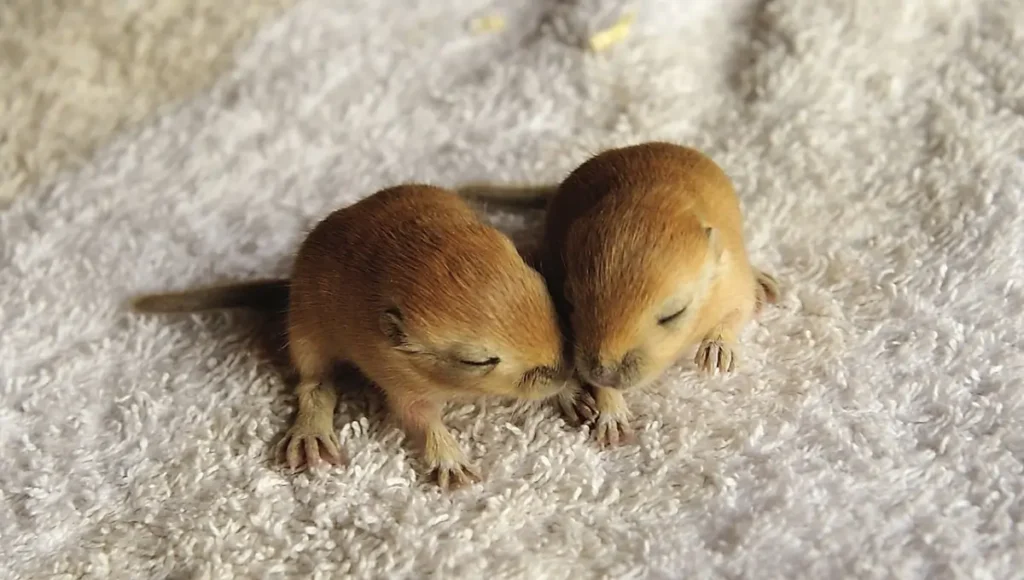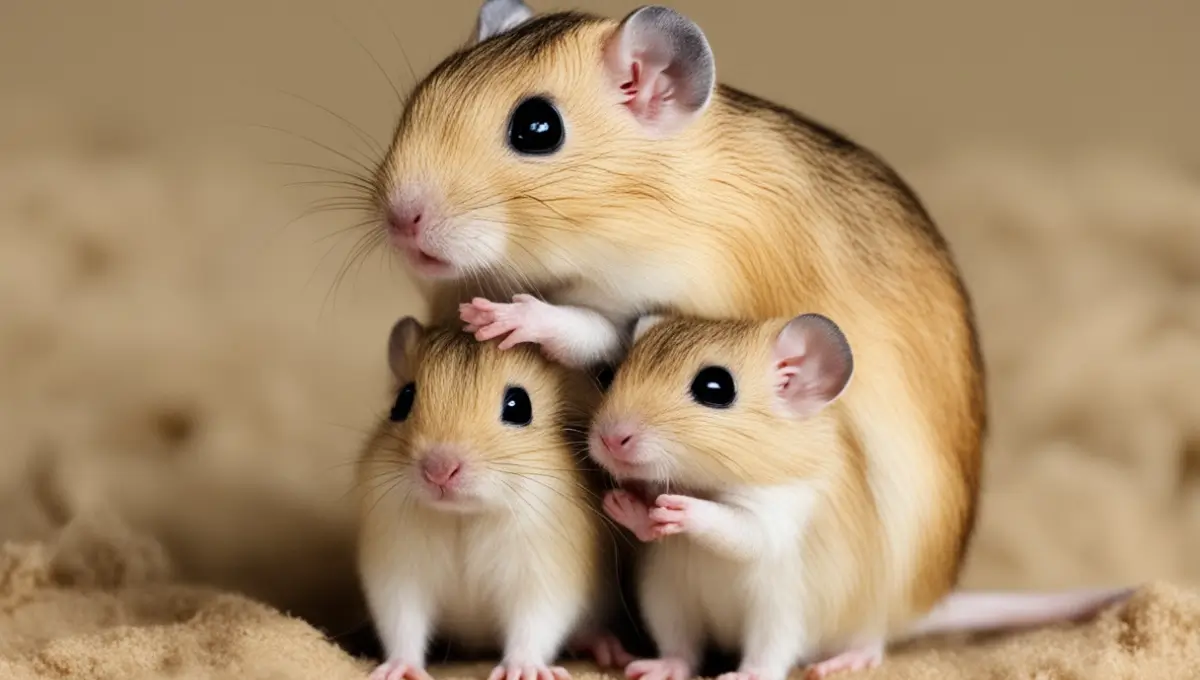When adding a new generation of baby gerbils, also known as pups, to your family, understanding gerbil pregnancy and providing proper care from the start is crucial for their health and well-being.
Gerbils, known for their sociable nature, thrive in secure, well-prepared environments, and when a pregnant gerbil is part of your pet family, creating a safe and warm habitat becomes even more essential.
As they experience significant changes day by day, from the early stages of gerbil pregnancy to the arrival of newborn pups, it’s important to be well-informed and ready for the journey ahead.
Identifying Pregnancy and Preparing for Birth
Recognizing Signs of Gerbil Pregnancy
Initial Signs
- Gerbils can exhibit rapid weight gain as a primary sign of pregnancy.
- Increased nesting behavior is commonly observed as they prepare for the arrival of their pups.
Physical Changes
- By the 24th day, the gerbil’s body may appear pear-shaped, and movements in the stomach can often be seen as pups shift positions.
- As the pregnancy progresses, the belly becomes rounder and may feel heavier, similar to holding a plum.
Behavioral Changes
- A pregnant gerbil might become more protective or even aggressive as she nears birth.
- There may be a noticeable increase in food and water intake during this period.
Preparing for Birth
Dietary Adjustments
- Enhance the mother gerbil’s diet with high-fat content to support her energy and protein needs during pregnancy.
Creating a Comfortable Environment:
- Avoid handling the pregnant gerbil excessively and refrain from changing the cage setup to minimize stress.
- It’s crucial not to clean the cage or rearrange it during the first week after the pups are born to provide a stable environment.
Monitoring and Timing
- Gerbil pregnancies last approximately 24-26 days, so monitoring the calendar is essential for anticipating the birth.
- Be aware that gerbils often give birth during the night or early morning, ensuring minimal disturbance during these times.
By closely observing these signs and making the necessary preparations, you can help ensure a safe and healthy birthing process for your gerbil.
Creating a Safe and Warm Environment

To ensure your gerbils thrive, it’s crucial to create a safe and warm environment that caters to their specific needs. Here’s a detailed guide on setting up the ideal habitat for your gerbil family:
Cage Requirements and Setup
- Select an Appropriate Enclosure: Opt for a glass tank with an escape-proof mesh lid or a wire enclosure with narrow bar spacing (no more than 3/8-inch) to prevent escapes and ensure adequate ventilation.
- Size Matters: Ensure the size of cage is spacious enough, with a minimum size of 36 square inches per gerbil. For a pair, a minimum of 180 square inches is recommended. A 20-gallon tank is ideal for a pair of gerbils.
- Avoid Certain Materials: Plastic habitats should be avoided as gerbils can chew through them. Wire enclosures are also not recommended as they can cause injuries to gerbils trying to escape.
Environmental Control
- Temperature and Humidity: Maintain a stable temperature between 60-70 degrees F (16-21 degrees C) and keep humidity levels between 30-50% to ensure comfort and prevent health issues.
- Draft-Free Area: Place the cage in a location away from direct sunlight, drafts, and high-frequency sounds to reduce stress and prevent overheating or chilling.
Substrate and Bedding
- Depth for Digging: Provide a deep layer of substrate, ideally 6-8 inches, to satisfy their natural digging instincts.
- Appropriate Bedding Material: Use absorbent, unscented, paper-based bedding to maintain cleanliness and comfort. Avoid scented or dusty bedding as it can cause respiratory issues.
Feeding and Hygiene
- Food and Water: Ensure constant access to fresh food and water. Place food dishes and water bottles securely within the enclosure to prevent tipping.
- Regular Cleaning: Clean the enclosure thoroughly at least weekly to minimize odors and maintain hygiene.
Enrichment and Comfort
- Toys and Accessories: Provide enrichment items like chew tubes and tunnels to keep your gerbils entertained and active.
- Secluded Areas: Include shady, secluded areas within the cage where gerbils can sleep and hide, providing them a sense of security.
By adhering to these guidelines, you can create a nurturing environment that supports the health and happiness of your gerbil family, ensuring they thrive in their new home.
Feeding and Nutrition for Mother and Pups

Optimal Diet for Pregnant and Nursing Gerbils
To support the heightened nutritional needs of pregnant and nursing gerbils, a balanced and protein-rich diet is essential. Here’s how to manage their feeding requirements:
Protein Sources
- Incorporate high-protein foods such as scrambled eggs, sunflower seeds, healthy pellets, and nuts into their diet.
- For additional protein, consider offering boiled or scrambled eggs, mealworms, crickets, and waxworms.
Commercial Diets
- Use a gerbil-specific formula such as Gerri Gerbil, which includes essential nutrients like alfalfa, maize, wheat, and soya to meet their dietary needs.
- For breeding pairs and babies under 3 months, select a diet with at least 16% protein and 7% fat, like the Ecotrition brand.
Vegetables and Fruits
- Regularly provide fresh vegetables like broccoli, peas, carrots, and spinach.
- Offer fruits such as apples, blueberries, and melon every other day to ensure variety and vitamin intake.
High-Calorie Treats
- During pregnancy, feed high-calorie treats such as unsalted nuts, small pieces of hard cheese, or plain boiled chicken to support energy needs and milk production.
Hydration and Grazing
- Ensure continuous access to fresh, clean drinking water via a sipper tube.
- Provide alfalfa hay for grazing, which is an excellent source of calcium for nursing females.
Transition to Solid Foods for Pups
Baby gerbils nurse from their mother for the first 5 weeks of life, after which they gradually transition to solid foods. Here’s how to manage this transition effectively:
Introducing Solids
- Start introducing high-quality pelleted gerbil food, grains, and small amounts of vegetables and fruits.
- Mix young gerbils’ diet with timothy hay, kale, and cooked sweet potatoes to ease the transition.
Continuous Water Supply:
- Maintain constant availability of fresh water to support hydration as pups begin consuming solid foods.
By carefully managing the diet of both mother gerbils and their pups, you can ensure they receive the necessary nutrients for healthy development and lactation.
Monitoring and Handling Newborns
Initial Care and Monitoring
Observation Post-Birth
- Newborn gerbil pups are born blind, hairless, and deaf, requiring careful observation for signs of health and mobility.
- Monitor daily for any signs of distress or lack of movement which could indicate health issues.
Parental Behavior
- Watch the behavior of the parents, especially the mother, to ensure they are not showing signs of stress or aggression towards the pups.
- Fathers are typically involved in raising the young and do not harm them, which is beneficial for the pups’ development.
Handling Newborns
- Begin gently handling the pups one by one for a few seconds each day from the second week to get them accustomed to human touch.
- Use a scooping motion to pick them up and keep them close to the ground to ensure safety.
Developmental Milestones
Physical Changes
- Pups’ eyes will start to show through their skin around day 8, indicating their future eye color.
- Expect to see fur growth and ear unfolding between days 8 and 17.
Social and Physical Development
- Human interaction from day 18 to 28 is crucial for teaching pups about being a gerbil and associating humans with positive experiences.
- Introduce a silent spinner wheel to acclimate them to exercise without risk.
Health Monitoring
- Keep an eye out for potential issues such as stillborns, runts, injuries, and signs of respiratory infections.
- Check for proper feeding and growth, taking any pups showing signs of malnourishment to the vet.
By adhering to these guidelines and closely monitoring each stage of development, you can help ensure a healthy start for newborn gerbils, setting the foundation for their future well-being.
Weaning and Feeding Solid Foods
Introduction to Weaning
Weaning is a crucial stage in the development of baby gerbils, typically beginning around three weeks of age. During this period, while pups still occasionally nurse, they gradually transition to solid foods. Understanding the process and timing can help ensure a smooth transition for the pups.
Step-by-Step Weaning Process
Introduction of Solid Foods
- At about three weeks, start introducing solid foods to the pups’ diet. This can include small, easily digestible seeds such as millet.
- Continue to provide access to the mother’s milk while they get accustomed to solid food.
Adjusting Diet Over Time
- By the fourth week, increase the variety of solid foods. Introduce shelled seeds but avoid high-fat seeds like sunflower seeds to maintain a balanced diet.
- Ensure fresh water is available at all times, as pups start drinking more frequently when they begin eating solid food.
Monitoring Progress
- Observe the pups’ ability to eat and digest the new foods. They should be fully weaned and no longer nursing by about five weeks of age.
- Watch for any signs of digestive issues or lack of interest in solid foods, which might require adjustments to their diet.
Guidelines for Separation and Independent Feeding
Timing for Separation
- To prevent unwanted pregnancies and promote independence, separate the pups from their parents and any opposite-sex siblings by eight weeks of age.
- This separation also encourages the pups to rely solely on solid foods.
Establishing Independent Feeding
- Post-separation, ensure each pup has individual access to food and water to foster independent eating habits.
- Continue providing a balanced diet that supports their growth and health needs as they move towards adulthood.
By following these guidelines, you can help ensure that the weaning process is effective and that the gerbil pups develop into healthy, independent adults.
Housing and Long-Term Care for Pups
Essential Housing Needs for Gerbil Pups
Proper Enclosure Setup
- Gerbils thrive in a gerbilarium that includes essential components such as a substrate for digging, a water bottle for hydration, items to chew on, nesting boxes for comfort, and various enrichment tools to stimulate their natural behaviors.
Maintenance and Cleanliness
- To maintain a healthy environment, spot-clean the gerbilarium daily and perform a deep cleaning weekly. This routine helps prevent the buildup of harmful bacteria and keeps the habitat fresh and safe for the pups.
Long-Term Care Considerations
Social and Emotional Development
- It’s crucial to separate baby gerbils from their parents between six to eight weeks to foster proper social and emotional development. Ideally, pups should be grouped into same-sex pairings or trios by the ninth week to prevent unwanted breeding and to support their social needs.
Health and Grooming
- Gerbils are natural self-groomers and rarely require baths. However, to assist in maintaining their fur’s cleanliness, provide access to weekly dust or sand baths to help them remove oil and dirt.
- Regular grooming routines should include spot cleaning with a damp washcloth or unscented baby wipes if necessary. Typically, gerbils keep their nails trimmed naturally through daily activities, but keep an eye on their nails to ensure they do not overgrow..
Reproductive Management
- Considering gerbils can produce around 50 young during their reproductive lifetime, it’s essential to manage their breeding carefully. Be aware that gerbils reach sexual maturity around four months old, so early separation and careful monitoring of their interactions are vital to control their population.
By following these guidelines, you can ensure that gerbil pups grow up in a safe, clean, and nurturing environment, equipped with everything they need for a healthy and happy life.
Conclusion
Throughout the article, we’ve explored the essential aspects of caring for gerbils, from the initial signs of pregnancy to the long-term needs of gerbil pups.
Understanding and preparing for the arrival of newborn pups, creating a safe and nurturing environment, and ensuring proper nutrition and care have been emphasized as crucial steps in supporting he mother’s and her children’s health and welfare.
These guidelines serve as a comprehensive foundation for gerbil owners embarking on the rewarding journey of raising these fascinating pets.
FAQs
What should I do if my gerbil has given birth?
When your gerbil has babies, it’s important to modify their habitat to ensure the safety of the newborn pups. Remove all toys and exercise equipment that could potentially harm the pups.
Only leave essential items like food, water, and nesting materials in the cage, and minimize the bedding. It’s also crucial to avoid cleaning the cage during the initial days after the pups are born to prevent disturbing them.
How can I tell if a gerbil is about to give birth?
A gerbil going into labor will generally appear calm and might engage in some stretching behaviors. The mother will be very involved in the birthing process, sometimes even pulling on her own placenta to aid in the delivery of her babies.
Is it safe to handle newborn gerbils?
You should start handling newborn gerbils gently once they open their eyes. This early interaction helps them associate humans with positive experiences like fun and adventure. It’s also a critical time for them to learn necessary survival and social skills from their parents or older siblings, which happens within about two weeks after their eyes open.
When is it appropriate to separate baby gerbils from their mother?
Baby gerbils should remain with their mother until they are at least six weeks old to ensure they develop properly both socially and emotionally. Although they become fully independent at six weeks, they can safely stay with their parents up to eight weeks of age.











